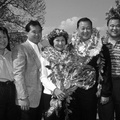The passage and signing of the Civil Liberties Act of 1988 remains the most significant event for Japanese Americans since World War II. In an unprecedented act of Congress, the U.S. government apologized for its unlawful forced removal and mass incarceration of thousands of people of Japanese ancestry during the war while providing redress payments of $20,000 to the survivors. While the success of the redress campaign represents a breakthrough in asserting political power for our numerically small Nikkei community, it did not come without a cost. The contentiousness within the greater Japanese American community over whether this issue should even be pursued and how redress should be obtained resurfaced old wounds and stirred traumatic memories for those who lived through the war. As in actual combat, there was collateral damage and casualties.
I was reminded of this after I attended a screening of a recent documentary on redress, Right of Passage, at the Skirball Cultural Center. The film, 138 minutes in length, is methodical in laying out the details of what was a two-decade struggle within the Nikkei community and in the halls of Congress. The landscape for Japanese American redress was vast and the number of individuals who impacted the movement, both positively and negatively, would have confused even Charles Dickens. The film features almost 30 people on screen, some who I have never heard speak on this topic before, including former U.S. Senator Alan Simpson, former Congressman Barney Frank, President Reagan’s Chief of Staff Ken Duberstein, and former New Jersey Governor Tom Kean. Right of Passage introduces new information by tapping different resources. For instance, director Janice Tanaka (who also produced the film with Nancy Araki) and editor and screenwriter Sreescanda and their team accessed recently declassified documents at the Ronald Reagan Presidential Library in Simi Valley, California.
Reagan, who became President in 1981 just as the Commission on Wartime Relocation and Internment of Civilians (CWRIC) was officially looking into the Japanese American World War II experience for Congress, is the centerpiece of the documentary. Introducing key administration memos and excerpts from Reagan’s diary, the film marks the President’s attitude as the Japanese American campaign progressed. While proponents struggled to get a bill through both houses of Congress, President Reagan stood as the final roadblock. The film posits a number of possible reasons why Reagan changed his mind and eventually signed the bill into law on August 10, 1988. Even today, individuals are arguing over who should get the credit for the redress campaign’s ultimate success.
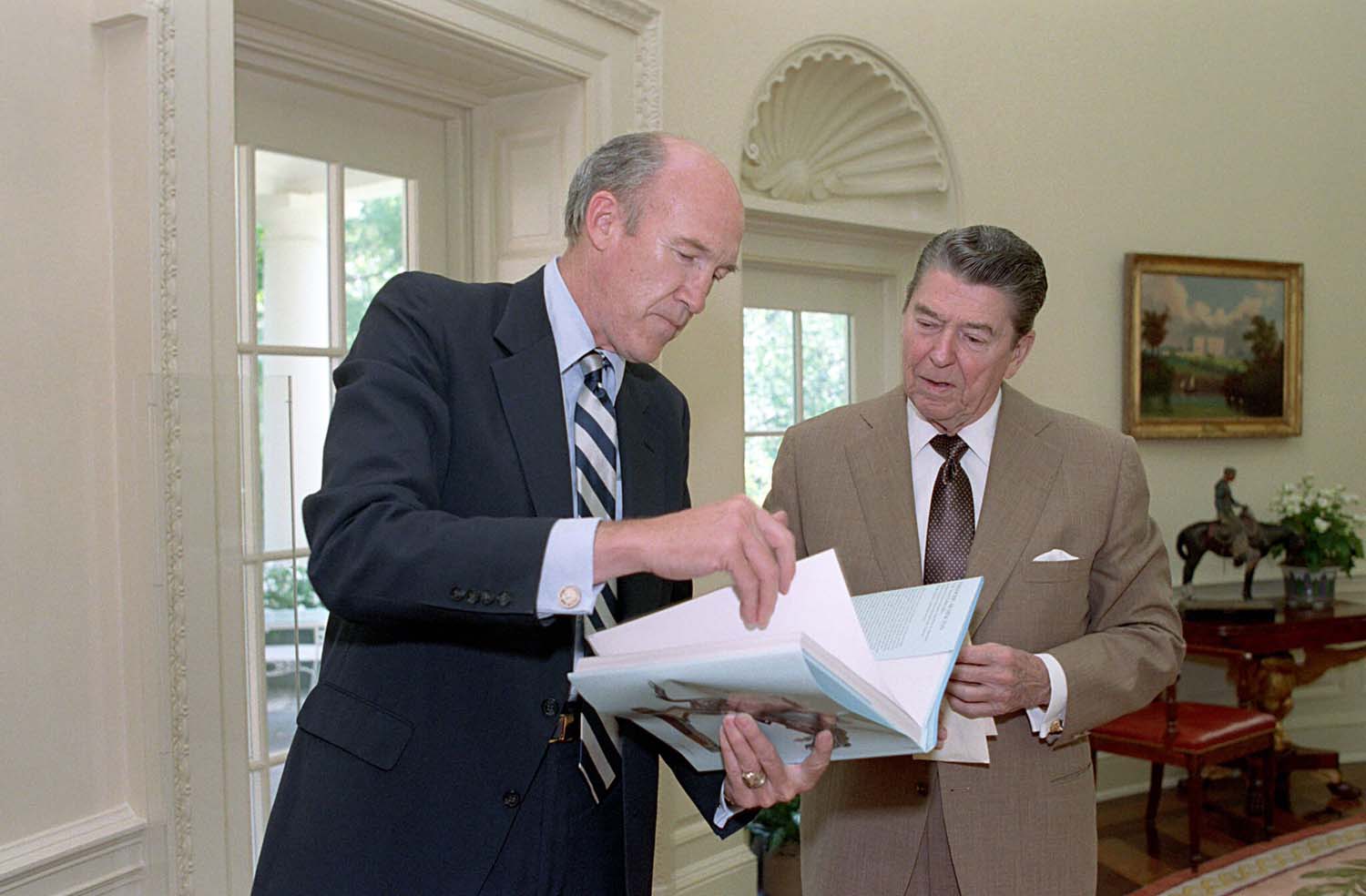
Another surprise from the film to me was the prominent appearance of Mike Masaoka. Masaoka’s role during the war as the Japanese American Citizens League (JACL) representative who cooperated with the government made him such a villain with many Japanese Americans that his name is used for a heartless character in George Takei’s Broadway musical, Allegiance. In the years during and after the redress campaign, I don’t remember Masaoka’s name mentioned prominently, except to excoriate him for his wartime maneuvers. Using research from the Mike Masaoka Collection at the University of Utah and key interviews, the film spends considerable time revealing Masaoka’s behind-the-scenes strategic direction for the JACL’s lobbying efforts.
Masaoka is still the most polarizing historic figure in Japanese American history. Born in California in 1915, he grew up in Utah where he lost his father when he was nine years old. By most accounts, he was a brilliant public relations advocate and lobbyist, but having grown up outside mainstream JA communities, Masaoka demonstrated attitudes that were abhorrent to most Nikkei. When the war began, he pushed extreme ideas to demonstrate Japanese American loyalty. As the film details, he proposed in writing to organize a Nisei “suicide battalion” whose actions would be guaranteed by their Issei parents held as hostages. Masaoka and the JACL advocated that JAs turn in anyone in their communities who could be suspected of being disloyal. He authored the Japanese American Creed, which is derided by a JACL member in the documentary as demeaning. Yet, Masaoka also enabled the limited but surprising Japanese American Evacuation Claims Act of 1948 and the landmark McCarran-Walter Immigration and Naturalization Act of 1952, which allowed Issei finally to become naturalized U.S. citizens.
John Tateishi provides the most nuanced view of Masaoka in the film. Tateishi acknowledges Masaoka’s hubris and observes that Mike had “the right intentions (but the) wrong thinking.” After the film screening, Tanaka answered questions from the audience at the Skirball and the subject of Masaoka came up. Tanaka compared Masaoka to Apple founder Steve Jobs in that he was brilliant, but abrasive and egotistical.

Tateishi’s role in the redress campaign is unique and I believe he was a true casualty of the internecine community fights. As Right of Passage makes clear, John—as the JACL representative—found himself in the crosshairs of not only those who opposed redress, but from other Nikkei community activists. Tateishi was appointed by JACL President Clifford Uyeda to head the organization’s National Committee for Redress. When the National Coalition for Redress and Reparations (NCRR) is organized, they carried the lingering suspicions and anger from the war toward the JACL and often expressed them directly to Tateishi.
Eventually, after the JACL leadership met with the four Japanese American members of Congress (Mineta, Rep. Robert Matsui, and senators Daniel Inouye and Spark Matsunaga), the proposal to form CWRIC (Inouye’s idea) emerged, much to the chagrin of many of the other redress advocates. Tateishi later confessed, “In my heart of hearts, … I did not want to go for a Commission.” But Inouye, as the group’s elder statesmen, firmly believed there needed to be a fact-finding body that could document what had happened to Japanese Americans during the war. Without the finding of fact, Inouye believed, redress legislation was impossible.
CWRIC turned out to be an essential part of the redress campaign, allowing Japanese Americans to publicly voice their grievances for the record. Its report, “Personal Justice Denied,” became the foundation of the redress legislation (and the National Council for Japanese American Redress’ lawsuit). As a Sansei born after the war whose family never openly discussed their imprisonment in a concentration camp in Colorado, I found the CWRIC’s testimonies from the Issei and Nisei survivors illuminating and emotional. It crystallized my own anger and sadness at what had been done to our families. As part of the panel discussion after the screening, former National JACL head Ron Wakabayashi confessed that before the redress campaign, “We (Sansei) disrespected our parents.” Once the Issei and Nisei revealed what they went through during the war, they finally got “the respect from their children” and many families were drawn closer together.
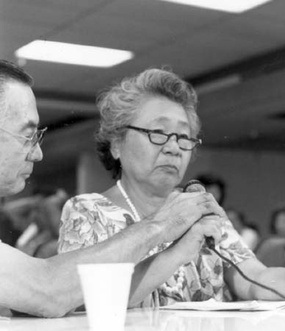
In the documentary, Tateishi brings up an important point that the Nisei and the especially the Issei had to go against their own cultural values to provide the testimony that the Sansei activists wanted. He recalled his own anguish as he witnessed the Issei and Nisei publicly share their pain with strangers. “It was the only time I’ve seen a Nisei man cry in public,” Tateishi recalled, adding that he himself was brought up to believe that it was shameful to do so. “It just felt really awful. It seemed like the worse thing to have done to them.” This was clearly part of the collateral damage from the campaign. Looking back from today, it is easy to say that it was psychologically beneficial for those individuals to vent their long repressed feelings. But, at that time in 1981, no one knew if redress would ever become a reality, so it was possible that the former inmates were put through the ringer for nothing.
Since no one knew at that time that there would be a positive outcome to CWRIC, many voiced their feelings that this government commission was created strictly to table the issue. The Seattle JACL chapter, feeling their initial efforts to spur redress were being ignored, broke away and joined with William Hohri and NCJAR to file a massive $27 billion class action lawsuit for reparations. Again, Tateishi took a lot of the heat. “I started getting threats from Japanese Americans. They said that we were backsliding and that we’d really sold everyone out.” In the film, Tateishi noted, “NCRR became our nemesis.”
In fairness to NCRR, once CWRIC began scheduling hearings, they embraced the opportunity to enable the former camp inmates to tell their stories for the record. Alan Nishio and Miya Iwataki both recall in the film pushing CWRIC to schedule more hearings around the country and then working at the grassroots level to encourage Japanese Americans to testify. NCRR activist Richard Katsuda once told me that before the Los Angeles hearings, NCRR had difficulty convincing any Issei to speak. Finally, some were persuaded when they were told, “Kodomo no tame ni (for the sake of the children).” Katsuda said it was nerve-racking for the Issei, many of them women, but after completing their task, he remembered they were singing on the ride back home.
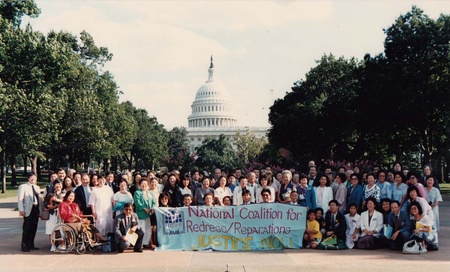
After CWRIC produced its 1983 report and recommended an apology and $20,000 individual payments to the survivors, the redress campaign finally began to consolidate its efforts around one bill (at one time there were three different bills) in Congress. Ironically, as things came together, Tateishi left his position at JACL in 1985 with Grant Ujifusa (Masaoka’s choice, according to Right of Passage) taking his place.
In 2008, when JANM marked the 20th anniversary of the signing of the Civil Liberties Act of 1988, I remember speaking to John over the phone about his role in the campaign. He recalled that after a decade, he was burnt out, estranged from his children and ready to do something else. When Reagan finally signed the bill into law, he told me, he was out of the city and did not celebrate this great achievement. If there was a casualty of the redress campaign, it was John. I’d like to think that JANM recognizing him on stage together with representatives of the other redress groups at the 2008 dinner celebration allowed John to celebrate his own role in the redress campaign.
Right of Passage details the many steps that were needed to pass the Civil Liberties Act. Many members of Congress signed on through direct appeal from one of the JA legislators. Community grassroots lobbyists persuaded others. Among the most effective lobbyists, the film points out, were women like Grayce Uyehara, Cherry Kinoshita, Mary Tsukamoto, and Carole Hayashino. Fate seemed to step in when committee chairs that were against the bill fortuitously moved on, allowing people like Barney Frank to step in and help. While Matsunaga individually persuaded over 70 Senators to sponsor the bill, Matsui and Mineta invoked their own family stories on the House floor to win more votes.
Interestingly, one of the main obstacles to redress was a name that I had forgotten about: S.I. Hayakawa. Hayakawa, who earned notoriety for his combativeness while the president of San Francisco State, was elected to the Senate from California in a stunning upset. His falling asleep while in chambers made the word “narcolepsy” famous. A Canadian who never experienced camp, he condemned the idea of redress, which, according to the film, influenced Reagan’s negative attitude. Like a lot of JAs, I think I just wanted to forget about Hayakawa when he left office.
After H.R. 442 passed the House and was about to pass the Senate, the question arose whether Reagan would veto the bill. Ujifusa, a Washington, D.C. insider, asked Governor Kean, who was scheduled to ride along in a limo with the President for a day, to remind Reagan that as an Army Captain, he had spoken at the funeral of Kazuo Masuda of the 442nd. Ujifusa also wrote a number of letters to the White House as well, but the film discounts their effectiveness since they did not reach the inner circle. The documentary notes these factors, but adds on two other reasons for why the President ultimately signed the bill into law.
One was his friendship with Senator Simpson, who used to visit with Reagan twice a week. Simpson, who grew up in Wyoming, actually met Mineta when both were Boy Scouts during the war. Because of this, Simpson remembered the Heart Mountain, Wyoming camp and shared his memories with Reagan. The other, according to Duberstein, was Reagan himself. “The most important thing (to the President) was he was redressing a wrong,” Duberstein explained. At the signing ceremony, the President also acknowledged Rose Matsui Ochi for sending him a clipping from the Pacific Citizen about Reagan’s participation in Kazuo Masuda’s funeral.
The question of what persuaded Reagan to sign the Civil Liberties Act of 1988 is currently being argued now. Gerald Yamada voiced his disapproval of Right of Passage in a letter to the Pacific Citizen and insisted that it was Ujifusa’s behind-the-scenes work that convinced Reagan. Screenwriter Sreescanda rebutted that letter.
I find it unfortunate that with a project that required so many people and things to fall in line, some calculated and some serendipitous, that there are disputes about who did what. As Miya Iwataki of NCRR said after the screening, “No one person made redress happen.” To me, the most sobering realization is that with all the hours of work, good will, political muscle, and grassroots organizing, the redress movement could have easily failed. One more obstacle, one more roadblock, or one more obstinate person could have doomed this quest. In my opinion, there was a certain destiny that was being fulfilled. Who gets credit for that?
* Right of Passage, a production of Nitto Tire Company with executive producers Tomo Mizutani and Ai Tokuno, is being screened at selected film festivals and community events including the San Francisco Day of Remembrance. Another screeing will be held at USC on April 7, 2016 at 7pm. To see its current schedule, go to: facebook.com/CivilLibertiesAct1988/events
© 2016 Chris Komai




